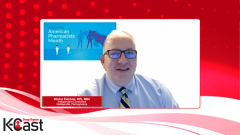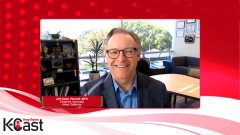
Myths and Concerns Surrounding Vaccines
With closing remarks, Mitchel Rothholz, RPh, MBA, and Jeff Goad, PharmD, MPH, discuss common myths circulating around COVID-19 vaccines and vaccination.
Episodes in this series

Mitchel Rothholz, RPh, MBA: In response to somebody saying they already had COVID-19 and have natural immunity, so they don’t need to get vaccinated, you gave the sound bite regarding extra protection and natural immunity waning. It isn’t as strong and robust as you get with the vaccine. That’s an important point regarding some of the myths and concerns that individuals have said as providers have had discussions with them.
One thing I’ll reiterate to the audience is if a person asks questions about the vaccine, it doesn’t mean they’re antivaccine. It means they’re contemplators. They’re looking at getting more information that gives them a comfort level. Our role as providers is to help give them the information and help them ultimately make the decision on whether to get vaccinated. That’s our role as pharmacists working with patients and communities. But there are other myths out there that people bring to the discussion. Jeff, can you give some insight on some that you’ve heard?
Jeff Goad, PharmD, MPH: [I’ve heard] some of the same ones that we’ve heard for other diseases, such as that the COVID-19 vaccine can cause COVID-19. As we’ve always pointed out before, even with inactive flu vaccines, sometimes it’s just unlucky timing. You got the flu vaccine, but you were exposed to the disease a couple of days before, so the vaccine didn’t have a chance to prevent the disease that was incubating in you. We still hear that. There was a lot of concern amplified through social media that it causes infertility. We’ve seen history repeat itself with the polio vaccine in Africa. When you start a myth, it can lead to lower vaccination rates.
The CDC [Centers for Disease Control and Prevention] has done a nice amount of work to debunk these myths and give good talking points and data to help people understand that myths are just that. Bad news travels faster than good news. Myths travel faster than facts. We have to combat that. It’s hard. When you go to a restaurant, you’re more likely to leave a bad review than a good review. But if you don’t put in some good reviews, people think maybe that’s true. These myths have a life of their own if people aren’t putting in the science and their opinion about getting the vaccine, especially those that are positive.
For example, I love to shift from the CDC’s initial messaging around vaccine hesitancy. It sounds like people were waiting or didn’t know. They were waiting for something to tip them off to vaccine confidence. That’s a brilliant strategy because it gets at the heart of what people are worried about. You want them to have confidence in the health care system, their provider, and their vaccine. Our job is to provide the science and practical recommendations that give people confidence to use the vaccines.
Mitchel Rothholz, RPh, MBA: Excellent. Thank you for stating that for our audience, because that’s important. If we’re confident with the information we provide, we’ll also help individuals be confident in their decision. One thing that came up in discussions of reviewing the bivalent vaccines was concern for myocarditis adverse effects being reported. Is there any concern with the vaccines different from what we looked at that people didn’t find to be a major problem with the previous vaccines?
Jeff Goad, PharmD, MPH: Yes, myocarditis certainly is something we watch for in younger populations. One thing we’ve also learned from booster doses is that the rates tend to be less with booster doses than they were with the initial series. But the same predictable pattern of who’s more at risk hasn’t changed. We see less incidence of myocarditis with the boosters. It’s still something to keep an eye on. It worries patients and parents. Fortunately, myocarditis usually isn’t a devastating adverse event, but it’s certainly something we need to warn patients about, especially in high-risk populations. Fortunately, we don’t see it at greater levels than we did with previous boosters or primary series.
Mitchel Rothholz, RPh, MBA: The other point to bring out is that it’s manageable. If a patient experiences it, it’s a manageable situation. That also stresses the importance of providers encouraging their patients to report and sign up for the v-safe program. As you mentioned earlier, one of the strengths of the program in the United States is having that ability to track, report, and respond to reports that come in. That’s a very important value to the success to our immunization program. Jeff, do you have any closing comments before we wrap up?
Jeff Goad, PharmD, MPH: There’s a saying: “Never let a crisis go to waste.” In other words, what can we learn from the pandemic? If we went through all the hardship, deaths, disability, and change in our way of life and don’t learn anything from it, then we have been through a horrible experience but are probably doomed to repeat it. We have to fund and keep the systems that we put in place, such as v-safe and the surveillance systems. They need money to keep going. We can’t let the public health infrastructure die away.
One of my greatest concerns is that we spent so much money at creating these systems to help surveil and give us real-time data to make better decisions to get vaccines faster to the market, but as the disease begins to ebb and case rates go lower, if funding, emphasis, and activity around our public health infrastructure fades, we’re in big trouble and we’re doomed to repeat. We need to start acting now to make these systems permanent, such as a national registry. We have a system in place for COVID-19. Make it for all vaccines, allowing this surveillance strategy. Keep those sites up, keep v-safe going, and keep all the systems in place so that we’re always ready for what’s around the corner rather than playing catchup, which we’ve had to do during this pandemic.
Mitchel Rothholz, RPh, MBA: The other important message is that pharmacists are a critical component of that immunization response and immunization neighborhood. As of September 15, 2022, pharmacies gave over 266.5 million doses of the COVID-19 vaccine. Because we’re recording this during [October, which is] American Pharmacists Month, it’s important for us to celebrate and thank everyone on the pharmacy team for the impact we’ve had on COVID-19. Jeff, you’re right. COVID-19 is just the start of the public health role for our profession. That needs to be sustained. For the next pandemic, we need to be around to help our communities.
With that remark, thank you for watching the Drug Tropics® K-Cast titled “Exploring the Continued Need for COVID-19 Vaccines and Boosters.” We hope you found this to be a valuable program for your clinical practice. Thank you for spending time with us.
Transcript edited for clarity.
Newsletter
Pharmacy practice is always changing. Stay ahead of the curve with the Drug Topics newsletter and get the latest drug information, industry trends, and patient care tips.






